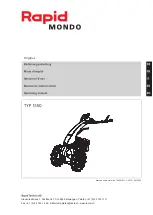
14
Snaphooks should not be used unless
approved for the application by the
manufacturer. Sections 10-16 provide
additional information concerning the
location and use of various attachments
that may be provided on this FBH.
10. Dorsal
– The dorsal attachment element
shall be used as the primary fall arrest
attachment unless the application allows
the use of an alternate attachment. The
dorsal attachment may also be used for
travel restraint or rescue. When support-
ed by the dorsal attachment during a
fall, the design of the FBH shall direct
load through the shoulder straps sup-
porting the user and around the thighs.
Supporting the user, post fall, by the
dorsal attachment will result in an upright
body position with a slight lean to the
front with some slight pressure to the
lower chest. Considerations should be
made when choosing a sliding versus
fixed dorsal attachment element. Slid-
ing dorsal attachments are generally
easier to adjust to different user sizes,
and allow a more vertical rest position
post fall, but can increase FBH stretch.
11. Sternal
– The sternal attachment may
be used as an alternative fall arrest
attachment in applications where the
dorsal attachment is determined to
be inappropriate by a competent per-
son and where there is no chance to
fall in a direction other than feet first.
Accepted practical uses for a sternal
attachment include, but are not limited
to, ladder climbing with a guided type
fall arrester, ladder climbing with an
overhead self-retracting lifeline for fall
arrest, work positioning and rope ac-
cess. The sternal attachment may also
be used for travel restraint or rescue.
When supported by the sternal attach-
ment during a fall, the design of the FBH
shall direct load through the shoulder
straps supporting the user and around
the thighs. Supporting the user, post fall,
by the sternal attachment will result in
roughly a sitting or cradled body position
with weight concentrated on the thighs,
buttocks and lower back. Supporting
the user during work positioning by
this sternal attachment will result in
an approximate upright body position.
If the sternal attachment is used for fall
arrest, the competent person evaluat-
ing the application should take meas-
ures to ensure that a fall can only oc-
cur feet first. This may include limiting
the allowable free fall distance. It may
be possible for a sternal attachment
incorporated into an adjustable style
chest strap to cause the chest strap
to slide up and possibly choke the user
during a fall, extraction, suspension,
etc. The competent person should con-
sider FBH models with a fixed sternal
attachment for these applications.
12. Frontal
– The frontal attachment serves
as a ladder climbing connection for guid-
ed type fall arresters where there is no
chance to fall in a direction other than
feet first or may be used for work posi-
tioning. Supporting the user, post fall or
during work positioning, by the frontal
attachment will result in a sitting body
position with the upper torso upright
with weight oncentrated on the thighs
and buttocks. When supported by the
frontal attachment the design of the
ansI/asse Z359.11 reQUIreMents















































